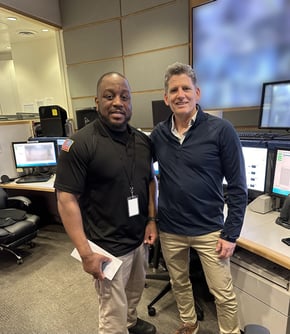More than 200 vehicles a day arrive at the iconic New York City campus where MSA Security’s Oronde (Ron) Ward serves as Project Manager for Vehicle Security Center operations. The landmark site offers public spaces, eateries, retailers, offices and historical points of interest. Ron and his team ensure that all vehicles are properly credentialed and screened before gaining access. It is an enormous job, but one that is a perfect match for this 14-year U.S. Marine Corps veteran and his skill set.
 Ron enlisted in the U.S. Marine Corps with a strong desire to serve the Nation. Originally stationed in Japan, a long way from his home state of New York, he served as a Motor Transport mechanic responsible for maintenance and repairs of diesel engine vehicles. Following the September 11th attacks, Ron was assigned to a Guard Force tasked with protecting the base while stationed on Camp Fuji, Japan. He received comprehensive training in emergency response tactics and execution, prepared to respond to enemy force at a moment’s notice. Ron separated from the Corps after several years as a career recruiter – and when considering the next step in his career, MSA Security proved the right fit.
Ron enlisted in the U.S. Marine Corps with a strong desire to serve the Nation. Originally stationed in Japan, a long way from his home state of New York, he served as a Motor Transport mechanic responsible for maintenance and repairs of diesel engine vehicles. Following the September 11th attacks, Ron was assigned to a Guard Force tasked with protecting the base while stationed on Camp Fuji, Japan. He received comprehensive training in emergency response tactics and execution, prepared to respond to enemy force at a moment’s notice. Ron separated from the Corps after several years as a career recruiter – and when considering the next step in his career, MSA Security proved the right fit.
“My time in the military provided the right mix of skills and experience for my current responsibilities with MSA. In addition to my tactical emergency response training, I am extremely familiar with the wide variety of trucks we screen every day having been a mechanic for many years,” explains Ron.
Vehicle-borne improvised explosive devices (VBIED) remain a preeminent security threat across the globe. Terrorists will often use vehicles to conceal homemade explosives with an intent to cause mass harm and garner widespread media coverage. Most notably on February 26, 1993, a truck bomb carrying a device containing over 1,000 lbs. of urea nitrate-hydrogen gas detonated in a basement level parking garage under the North Tower of the World Trade Center. Six people were killed and more than 1,000 injured. A layered security approach is critical in mitigating these attacks. For Ron and his team of MSA bomb technicians, Explosive Detection Canine Teams and security experts, that means screening every single vehicle that enters the gate to detect any large-scale explosive devices. They utilize a multi-pronged screening protocol.
Credentialling: All vehicle drivers are screened by well-trained security personnel for valid driver’s license and proper delivery manifest documents.
X-ray Screening: A state-of-the-art truck screening gantry utilizes sophisticated X-ray screening technology to detect explosive threats. Images are examined in real-time by trained bomb and Explosive Ordinance Disposal (EOD) techs.
Explosive Detection Canine Teams: Pre-vetted executives and select personnel park on site and all their vehicles are screened by bomb dogs.
Like Ron, the members of his team are former military or law enforcement, which he says is a distinct advantage. “These individuals carry real-world experience and a knowledge base that is unmatched in addressing risks we see in today’s threat landscape,” says Ron. “We also ensure that they receive ongoing training to stay current on the ever-evolving IED presentations and changing tradecraft.”
As a husband and father, Ron has plenty to keep him busy when he is not at work. He loves staying fit and tackling projects around the house, but he maintains an incredible passion for his work that energizes him for each new day. He considers it a privilege to work alongside such a talented team of fellow veterans who embrace the same mission. “We work at an iconic location that means so much to the public. It is an honor that my team and I can do what we do to keep the countless number of people who pass through here every day safe. That’s a good feeling.”
